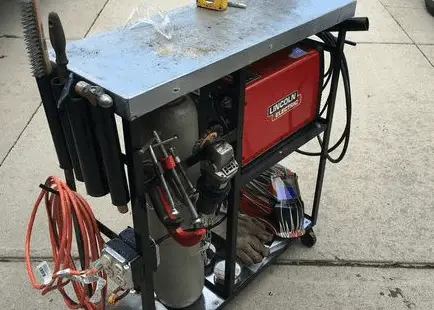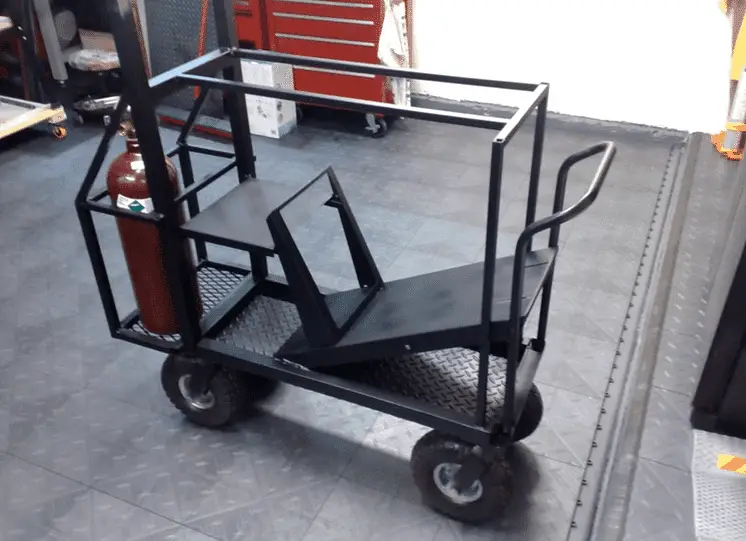If you’ve spent any amount of time welding, or even simply researching the top-rated welding carts, you’ve probably wondered, why are welding carts angled? Good question! There are really three main reasons most welding carts you’ll come across feature an angled top shelf: visibility of the controls, maintaining a lower center of gravity for tip prevention, and avoiding the piling-on of welding equipment and other items.
All of these factors combined are intended to provide the ideal work space for you as a welder. That is, these reasons for setting the top shelf at an angle, while perhaps somewhat strange at first, are really there to ensure a safe and efficient working environment for you and your colleagues. While you can definitely find level welding carts, or even craft your own, after reading this article, we’re certain you’ll see the true benefits of that slight slant whether when buying a pro cart or considering a DIY welding cart project.
Why Are Welding Carts Angled?

In this article, we’re going to walk you through the primary reasons for this unexplained tilt to your welding cart.
First, we’ll cover the benefits of an angled welding cart from a safety perspective, including the visibility of welding controls, as well as the importance of a low center of gravity for your cart in order to keep the cart from toppling over.
Next, we’ll consider some more day-to-day, practical implications of having an angled welding cart, such as how this slight angle can prevent you and others from piling items on top of the cart shelf. It might seem silly, but having a built-in mechanism that keeps you from loading the top shelf of your cart with other equipment (and even just everyday junk) is actually a major benefit.
Visibility and Reachability of Controls
Perhaps the single most important reason that the majority of welding carts have an angled top shelf is to promote the visibility and reachability of your welding controls. By setting this shelf at an angle, the cart allows you to see the controls at a direct angle, which prevents parallax.
No, no, we’re not talking about a DC Comics villain here. Parallax is simply the term that describes the illusory difference in the apparent position of an object depending on the viewer’s point of view. That is, if you look at an object from one point of view and then change your vantage point, the object will appear as though it’s in a different position relative to objects around it.

This is an important obstacle to overcome when it comes to welding. You want to be able to see the controls and gauges of your welding equipment accurately. So the angle of the welding cart allows the proper vantage point to ensure you see everything “as it really is.” The further benefit of this angle with regard to controls is that it puts you, the welder, in a better position to manipulate the controls easily.
A level shelf might require you to stoop down to properly see and manipulate the controls with the accuracy needed for this sensitive work.
Low Center of Gravity for Tip Prevention
Another major benefit to the angled design of many welding carts is that it lowers the cart’s center of gravity. This might not seem like such an important feature, but if you consider the cataclysmic repercussions that could ensue if your cart was to topple over, you’ll see why this is so crucial.
Welders are not cheap instruments, and a hard tumble onto a concrete floor would likely cause serious damage to even the most durable equipment. That’s why the lower center of gravity created by an angled welding cart is so critical. It significantly reduces the chances of an unforeseen accident or trip causing your cart to tip. You’ll definitely want to keep this in mind before you seriously consider a straight-level welding cart.
Preventing Pile-On
This last point is probably less of an intentional benefit of angling the top shelf of your welding cart; it’s likely just a happy accident. But the fact is, if the top shelf of your welding cart is at a bit of an angle, you’re far less likely to be tempted to set things on top of it. This is a great benefit for a couple of reasons: one, it will help keep your work area clean and efficient, and two, it will prevent you from piling up so much stuff on top that you can’t safely move the cart!

With regard to keeping your area clean, this angled design is clearly helpful. You’ll never be tempted to set a beverage down on your work surface, leading to potential spills or other catastrophic messes.
Further, you won’t have as much of an issue with cluttering up your work environment. The angled shelf makes it rather inconvenient to set superfluous items near your welding equipment, which will keep your most important work area tidy and ready to use.
As for promoting the mobility of your cart, the angled shelf won’t allow you to set a bunch of unsupported or easy-to-lose items on top. With this top shelf clear of extra equipment and junk, you’ll always be able to move your cart about freely, without worrying about things falling off or the cart toppling over under all the weight. It’s essentially a friendly reminder from your cart to keep your work area clean. How thoughtful!
Do I Have to Use an Angled Welding Cart?
The bottom line is this: you don’t have to use an angled welding cart. In fact, you don’t have to use any kind of welding cart, really. However, we’ve found—and we hope you’ll agree having read this article—that the slight angle of most welding carts is far more of a feature than a bug.
This slanted shelf simultaneously offers a better vantage point for viewing your equipment, provides ideal reachability of your controls, creates a safer low center of gravity for your cart, and effectively prevents unnecessary clutter than can limit the mobility of your cart and welding equipment.
So, no, you don’t need that extra angle, but we think you’ll be much better off with it than without!
FAQs
1. Why are welding carts tilted?
By tilting this shelf, the cart allows you to see the controls directly, which eliminates parallax. However, the primary reason that the majority of welding cards are tilted is to improve control visibility and reachability.
2. What equipment do welders use?
The majority of welders use an angle grinder to smooth out joints, wire brushes to clean or abrade metal surfaces before welding, a chipping slag hammer, C-clamps, ball peen hammer, electrode tip cleaners, flint strikers, needle nose, and linesmen cutting pliers.
3. What are the 3 main types of welding?
While there are numerous welding processes, the most common are stick welding, inert metal gas (MIG) welding, and inert tungsten gas (TIG) welding.

